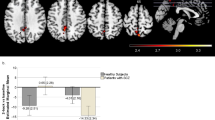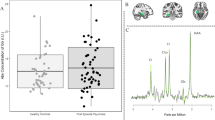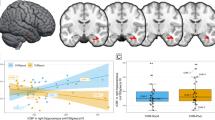Abstract
A Val66Met single-nucleotide polymorphism (SNP) in the brain-derived neurotrophic factor (BDNF) gene impairs activity-dependent BDNF release in cultured hippocampal neurons and predicts impaired memory and exaggerated basal hippocampal activity in healthy humans. Several clinical genetic association studies along with multi-modal evidence for hippocampal dysfunction in schizophrenia indirectly suggest a relationship between schizophrenia and genetically determined BDNF function in the hippocampus. To directly test this hypothesized relationship, we studied 47 medication-free patients with schizophrenia or schizoaffective disorder and 74 healthy comparison individuals with genotyping for the Val66Met SNP and [15O]H2O positron emission tomography (PET) to measure resting and working memory-related hippocampal regional cerebral blood flow (rCBF). In patients, harboring a Met allele was associated with significantly less hippocampal rCBF. This finding was opposite to the genotype effect seen in healthy participants, resulting in a significant diagnosis-by-genotype interaction. Exploratory analyses of interregional resting rCBF covariation revealed a specific and significant diagnosis-by-genotype interaction effect on hippocampal-prefrontal coupling. A diagnosis-by-genotype interaction was also found for working memory-related hippocampal rCBF change, which was uniquely attenuated in Met allele-carrying patients. Thus, both task-independent and task-dependent hippocampal neurophysiology accommodates a Met allelic background differently in patients with schizophrenia than in control subjects. Potentially consistent with the hypothesis that cellular sequelae of the BDNF Val66Met SNP interface with aspects of schizophrenic hippocampal and frontotemporal dysfunction, these results warrant future investigation to understand the contributions of unique patient trait or state variables to these robust interactions.
This is a preview of subscription content, access via your institution
Access options
Subscribe to this journal
Receive 12 print issues and online access
$259.00 per year
only $21.58 per issue
Buy this article
- Purchase on Springer Link
- Instant access to full article PDF
Prices may be subject to local taxes which are calculated during checkout



Similar content being viewed by others
References
Cohen-Cory S, Kidane AH, Shirkey NJ, Marshak S . Brain-derived neurotrophic factor and the development of structural neuronal connectivity. Dev Neurobiol 2010; 70: 271–288.
Patterson SL, Abel T, Deuel TAS, Martin KC, Rose JC, Kandel ER . Recombinant BDNF rescues deficits in basal synaptic transmission and hippocampal LTP in BDNF knockout mice. Neuron 1996; 16: 1137–1145.
Lu B, Gottschalk W . Modulation of hippocampal synaptic transmission and plasticity by neurotrophins. Prog Brain Res 2000; 128: 231–241.
Lu B . BDNF and activity-dependent synaptic modulation. Learn Mem 2003; 10: 86–98.
Tartaglia N, Du J, Tyler WJ, Neale E, Pozzo-Miller L, Lu B . Protein synthesis-dependent and -independent regulation of hippocampal synapses by brain-derived neurotrophic factor. J Biol Chem 2001; 276: 37585–37593.
Barnabe-Heider F, Miller FD . Endogenously produced neurotrophins regulate survival and differentiation of cortical progenitors via distinct signaling pathways. J Neurosci 2003; 23: 5149–5160.
Kang H, Schuman E . Long-lasting neurotrophin-induced enhancement of synaptic transmission in the adult hippocampus. Science 1995; 267: 1658–1662.
Sairanen M, Lucas G, Ernfors P, Castren M, Castren E . Brain-derived neurotrophic factor and antidepressant drugs have different but coordinated effects on neuronal turnover, proliferation, and survival in the adult dentate gyrus. J Neurosci 2005; 25: 1089–1094.
Lipska BK, Khaing ZZ, Weickert CS, Weinberger DR . BDNF mRNA expression in rat hippocampus and prefrontal cortex: effects of neonatal ventral hippocampal damage and antipsychotic drugs. Eur J Neurosci 2001; 14: 135–144.
Owens SF, Picchioni MM, Rijsdijk FV, Stahl D, Vassos E, Rodger AK et al. Genetic overlap between episodic memory deficits and schizophrenia: results from The Maudsley Twin Study. Psychol Med 2011; 41: 521–532.
Tamminga CA, Thaker GK, Buchanan R, Kirkpatrick B, Alphs LD, Chase TN et al. Limbic system abnormalities identified in schizophrenia using positron emission tomography with fluorodeoxyglucose and neocortical alterations with deficit syndrome. Arch Gen Psychiatry 1992; 49: 522–530.
Nordahl TE, Kusubov N, Carter C, Salamat S, Cummings AM, O’Shora-Celaya L et al. Temporal lobe metabolic differences in medication-free outpatients with schizophrenia via the PET-600. Neuropsychopharmacology 1996; 15: 541–554.
Andreasen NC, O’Leary DS, Flaum M, Nopoulos P, Watkins GL, Ponto LLB et al. Hypofrontality in schizophrenia: distributed dysfunctional circuits in neuroleptic-naïve patients. Lancet 1997; 349: 1730–1734.
Heckers S, Rauch S, Goff D, Savage C, Schacter D, Fischman A et al. Impaired recruitment of the hippocampus during conscious recollection in schizophrenia. Nat Neurosci 1998; 1: 318–323.
Ragland JD, Gur RC, Valdez JN, Loughead J, Elliott M, Kohler C et al. Levels-of-processing effect on frontotemporal function in schizophrenia during word encoding and recognition. Am J Psychiatry 2005; 162: 1840–1848.
Meyer-Lindenberg A, Poline J-B, Kohn PD, Holt JL, Egan MF, Weinberger DR et al. Evidence for abnormal cortical functional connectivity during working memory in schizophrenia. Am J Psychiatry 2001; 158: 1809–1817.
Buckley PF, Mahadik S, Pillai A, Terry A . Neurotrophins and schizophrenia. Schizophr Res 2007; 94: 1–11.
Shoval G, Weizman A . The possible role of neurotrophins in the pathogenesis and therapy of schizophrenia. Eur Neuropsychopharmacol 2005; 15: 319–329.
Angelucci F, Brene S, Mathe AA . BDNF in schizophrenia, depression and corresponding animal models. Mol Psychiatry 2005; 10: 345–352.
Durany N, Michel T, Zöchling R, Boissl KW, Cruz-Sánchez FF, Riederer P et al. Brain-derived neurotrophic factor and neurotrophin 3 in schizophrenic psychoses. Schizophr Res 2001; 52: 79–86.
Takahashi M, Shirakawa O, Toyooka K, Kitamura N, Hashimoto T, Maeda K et al. Abnormal expression of brain-derived neurotrophic factor and its receptor in the corticolimbic system of schizophrenic patients. Mol Psychiatry 2000; 5: 293–300.
Wong J, Hyde TM, Cassano HL, Deep-Soboslay A, Kleinman JE, Weickert CS . Promoter specific alterations of brain-derived neurotrophic factor mRNA in schizophrenia. Neuroscience 2010; 169: 1071–1084.
Hashimoto T, Bergen SE, Nguyen QL, Xu B, Monteggia LM, Pierri JN et al. Relationship of brain-derived neurotrophic factor and its receptor TrkB to altered inhibitory prefrontal circuitry in schizophrenia. J Neurosci 2005; 25: 372–383.
Weickert CS, Hyde TM, Lipska BK, Herman MM, Weinberger DR, Kleinman JE . Reduced brain-derived neurotrophic factor in prefrontal cortex of patients with schizophrenia. Mol Psychiatry 2003; 8: 592–610.
Green MJ, Matheson SL, Shepherd A, Weickert CS, Carr VJ . Brain-derived neurotrophic factor levels in schizophrenia: a systematic review with meta-analysis. Mol Psychiatry 2010; 16: 960–972.
Chen D, Wang J, Wang B, Yang S, Zhang C, Zheng Y et al. Decreased levels of serum brain-derived neurotrophic factor in drug-naive first-episode schizophrenia: relationship to clinical phenotypes. Psychopharmacology (Berl) 2009; 207: 375–380.
Vinogradov S, Fisher M, Holland C, Shelly W, Wolkowitz O, Mellon SH . Is serum brain-derived neurotrophic factor a biomarker for cognitive enhancement in schizophrenia? Biol Psychiatry 2009; 66: 549–553.
Chao HM, Kao HT, Porton B . BDNF Val66Met variant and age of onset in schizophrenia. Am J Med Genet B Neuropsychiatr Genet 2008; 147B: 505–506.
Neves-Pereira M, Cheung JK, Pasdar A, Zhang F, Breen G, Yates P et al. BDNF gene is a risk factor for schizophrenia in a Scottish population. Mol Psychiatry 2005; 10: 208–212.
Muglia P, Vicente AM, Verga M, King N, Macciardi F, Kennedy JL . Association between the BDNF gene and schizophrenia. Mol Psychiatry 2003; 8: 146–147.
Zai GCM, Zai CCH, Chowdhury NI, Tiwari AK, Souza RP, Lieberman JA et al. The role of brain-derived neurotrophic factor (BDNF) gene variants in antipsychotic response and antipsychotic-induced weight gain. Prog Neuropsychopharmacol Biol Psychiatry 2012; 39: 96–101.
Egan MF, Kojima M, Callicott JH, Goldberg TE, Kolachana BS, Bertolino A et al. The BDNF val66met polymorphism affects activity-dependent secretion of BDNF and human memory and hippocampal function. Cell 2003; 112: 257–269.
Lahti AC, Holcomb HH, Weiler MA, Medoff DR, Tamminga CA . Functional effects of antipsychotic drugs: comparing clozapine with haloperidol. Biol Psychiatry 2003; 53: 601–608.
First MB, Spitzer RL, Miriam G, Williams JBW . User’s Guide for the Structured Clinical Interview for DSM-IV Axis I Disorders: SCID-I, Research Version. Biometrics Research, New York State Psychiatric Institute: New York, NY, 2001.
Kay SR, Fiszbein A, Opler LA . The positive and negative syndrome scale (PANSS) for schizophrenia. Schizophr Bull 1987; 13: 261–276.
Wei SM, Eisenberg DP, Kohn PD, Kippenhan JS, Kolachana BS, Weinberger DR et al. Brain-derived neurotrophic factor Val66Met polymorphism affects resting regional cerebral blood flow and functional connectivity differentially in women versus men. J Neurosci 2012; 32: 7074–7081.
Eisenberg DP, Sarpal D, Kohn PD, Meyer-Lindenberg A, Wint D, Kolachana B et al. Catechol-o-methyltransferase valine(158)methionine genotype and resting regional cerebral blood flow in medication-free patients with schizophrenia. Biol Psychiatry 2010; 67: 287–290.
Wigginton JE, Cutler DJ, Abecasis GaR. A . Note on exact tests of Hardy-Weinberg equilibrium. Am J Hum Genet 2005; 76: 887–893.
Meyer-Lindenberg AS, Olsen RK, Kohn PD, Brown T, Egan MF, Weinberger DR et al. Regionally specific disturbance of dorsolateral prefrontal-hippocampal functional connectivity in schizophrenia. Arch Gen Psychiatry 2005; 62: 379–386.
Forman SD, Cohen JD, Fitzgerald M, Eddy WF, Mintun MA, Noll DC . Improved assessment of significant activation in functional magnetic resonance imaging (fMRI): use of a cluster-size threshold. Magn Reson Med 1995; 33: 636–647.
Kovalchuk Y, Hanse E, Kafitz KW, Konnerth A . Postsynaptic induction of BDNF-mediated long-term potentiation. Science 2002; 295: 1729–1734.
Lohof AM, Ip NY, Poo MM . Potentiation of developing neuromuscular synapses by the neurotrophins NT-3 and BDNF. Nature 1993; 363: 350–353.
Binder DK, Croll SD, Gall CM, Scharfman HE . BDNF and epilepsy: too much of a good thing? Trends Neurosci 2001; 24: 47–53.
Rex CS, Lin C-Y, Kramar EA, Chen LY, Gall CM, Lynch G . Brain-derived neurotrophic factor promotes long-term potentiation-related cytoskeletal changes in adult hippocampus. J Neurosci 2007; 27: 3017–3029.
Messaoudi E, BÃ¥rdsen K, Srebro B, Bramham CR . Acute intrahippocampal infusion of BDNF induces lasting potentiation of synaptic transmission in the rat dentate gyrus. J Neurophysiol 1998; 79: 496–499.
Sherwood NT, Lo DC . Long-term enhancement of central synaptic transmission by chronic brain-derived neurotrophic factor treatment. J Neurosci 1999; 19: 7025–7036.
Medoff DR, Holcomb HH, Lahti AC, Tamminga CA . Probing the human hippocampus using rCBF: contrasts in schizophrenia. Hippocampus 2001; 11: 543–550.
Erkwoh R, Sabri O, Steinmeyer EM, Büll U, Saß H . Psychopathological and SPECT findings in never-treated schizophrenia. Acta Psychiatr Scand 1997; 96: 51–57.
Malaspina D, Harkavy-Friedman J, Corcoran C, Mujica-Parodi L, Printz D, Gorman JM et al. Resting neural activity distinguishes subgroups of schizophrenia patients. Biol Psychiatry 2004; 56: 931–937.
Molina V, Sanz J, Sarramea F, Benito C, Palomo T . Prefrontal atrophy in first episodes of schizophrenia associated with limbic metabolic hyperactivity. J Psychiatr Res 2005; 39: 117–127.
al-Mousawi AH, Evans N, Ebmeier KP, Roeda D, Chaloner F, Ashcroft GW . Limbic dysfunction in schizophrenia and mania. A study using 18F-labelled fluorodeoxyglucose and positron emission tomography. Br J Psychiatry 1996; 169: 509–516.
Schobel SA, Lewandowski NM, Corcoran CM, Moore H, Brown T, Malaspina D et al. Differential targeting of the CA1 subfield of the hippocampal formation by schizophrenia and related psychotic disorders. Arch Gen Psychiatry 2009; 66: 938–946.
Whitfield-Gabrieli S, Thermenos HW, Milanovic S, Tsuang MT, Faraone SV, McCarley RW et al. Hyperactivity and hyperconnectivity of the default network in schizophrenia and in first-degree relatives of persons with schizophrenia. Proc Natl Acad Sci USA 2009; 106: 1279–1284.
Lahti AC, Weiler MA, Holcomb HH, Tamminga CA, Carpenter WT, McMahon R . Correlations between rCBF and symptoms in two independent cohorts of drug-free patients with schizophrenia. Neuropsychopharmacology 2005; 31: 221–230.
Ninan I, Bath KG, Dagar K, Perez-Castro R, Plummer MR, Lee FS et al. The BDNF Val66Met polymorphism impairs NMDA receptor-dependent synaptic plasticity in the hippocampus. J Neurosci 2010; 30: 8866–8870.
Liu R-J, Lee FS, Li X-Y, Bambico F, Duman RS, Aghajanian GK . Brain-derived neurotrophic factor Val66Met allele impairs basal and ketamine-stimulated synaptogenesis in prefrontal cortex. Biol Psychiatry 2012; 71: 996–1005.
Thomason ME, Yoo DJ, Glover GH, Gotlib IH . BDNF genotype modulates resting functional connectivity in children. Front Hum Neurosci 2009; 3: 55.
Veltman DJ, Friston KJ, Sanders G, Price CJ . Regionally specific sensitivity differences in fMRI and PET: where do they come from? NeuroImage 2000; 11: 575–588.
Wolf RC, Vasic N, Sambataro F, Höse A, Frasch K, Schmid M et al. Temporally anticorrelated brain networks during working memory performance reveal aberrant prefrontal and hippocampal connectivity in patients with schizophrenia. Prog Neuropsychopharmacol Biol Psychiatry 2009; 33: 1464–1473.
Goldman-Rakic PS, Selemon LD, Schwartz ML . Dual pathways connecting the dorsolateral prefrontal cortex with the hippocampal formation and parahippocampal cortex in the rhesus monkey. Neuroscience 1984; 12: 719–743.
Freyberg Z, Ferrando SJ, Javitch JA . Roles of the Akt/GSK-3 and Wnt signaling pathways in schizophrenia and antipsychotic drug action. Am J Psychiatry 2009; 167: 388–396.
Nicodemus KK, Marenco S, Batten AJ, Vakkalanka R, Egan MF, Straub RE et al. Serious obstetric complications interact with hypoxia-regulated/vascular-expression genes to influence schizophrenia risk. Mol Psychiatry 2008; 13: 873–877.
Acknowledgements
This research was supported by the Intramural Research Program, National Institute of Mental Health, National Institutes of Health, Bethesda, MD 20892. We would like to thank the staff of the NIH PET Center and the NIMH GCAP Inpatient Program for their assistance in data acquisition.
Author information
Authors and Affiliations
Corresponding author
Ethics declarations
Competing interests
The authors declare no conflict of interest.
Additional information
Supplementary Information accompanies the paper on the Molecular Psychiatry website
Rights and permissions
About this article
Cite this article
Eisenberg, D., Ianni, A., Wei, SM. et al. Brain-derived neurotrophic factor (BDNF) Val66Met polymorphism differentially predicts hippocampal function in medication-free patients with schizophrenia. Mol Psychiatry 18, 713–720 (2013). https://doi.org/10.1038/mp.2012.187
Received:
Revised:
Accepted:
Published:
Issue Date:
DOI: https://doi.org/10.1038/mp.2012.187
Keywords
This article is cited by
-
The schizophrenia risk gene ZNF804A: clinical associations, biological mechanisms and neuronal functions
Molecular Psychiatry (2017)
-
The BDNF gene Val66Met polymorphism as a modifier of psychiatric disorder susceptibility: progress and controversy
Molecular Psychiatry (2015)
-
Neurodevelopment, GABA System Dysfunction, and Schizophrenia
Neuropsychopharmacology (2015)
-
Targeted deletion of the C-terminus of the mouse adenomatous polyposis coli tumor suppressor results in neurologic phenotypes related to schizophrenia
Molecular Brain (2014)
-
Olanzapine induced DNA methylation changes support the dopamine hypothesis of psychosis
Journal of Molecular Psychiatry (2013)



